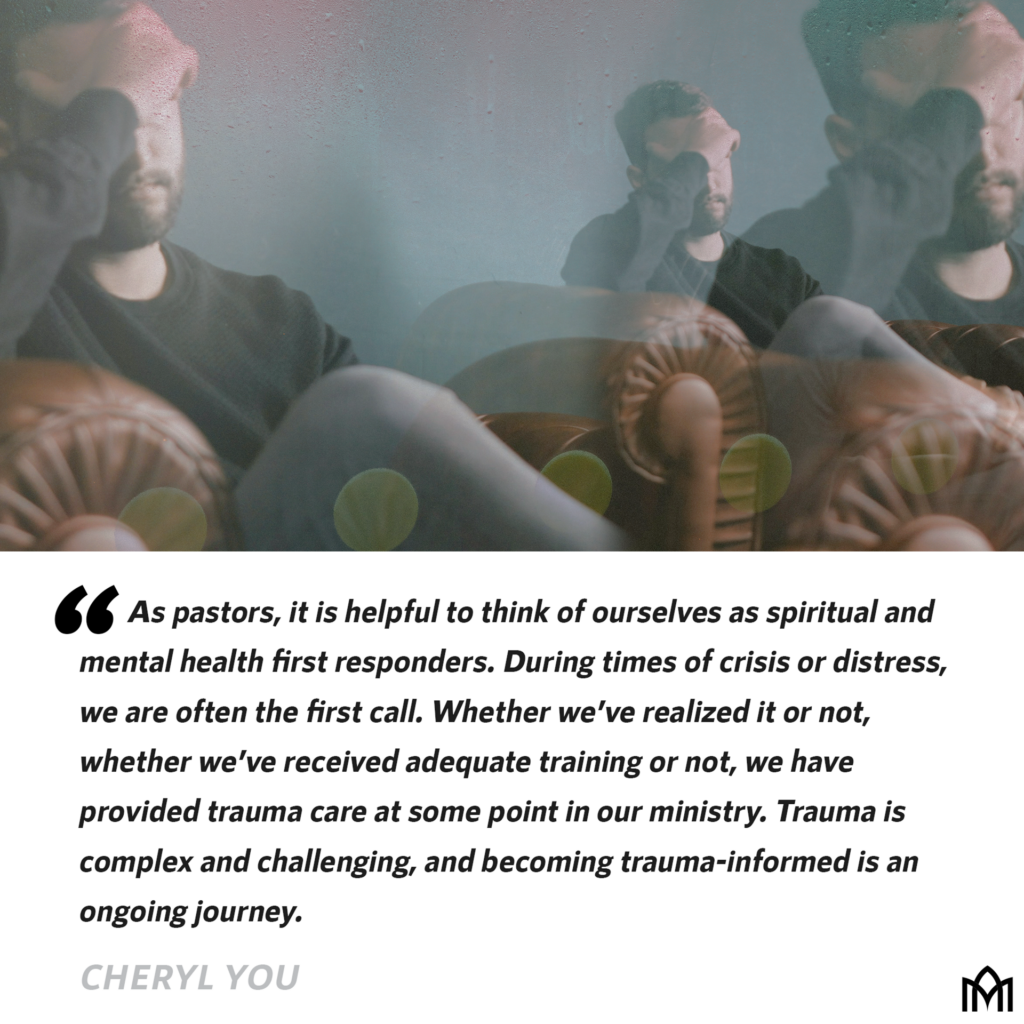The Ongoing Journey of Becoming a Trauma-Informed Pastor
Trauma is an ever-present reality in our twenty-first century world. It’s not that trauma was recently invented, but rather that the developments in fields as diverse as neuroscience, psychology, and medicine have brought a greater awareness of the significance and impact of trauma. The effects of trauma are wide-ranging; it affects not only mental and emotional health but is also connected to chronic medical conditions, reduced lifespans, substance misuse, and relational difficulties. Many of the people in our pews have a trauma history1A recent Barna study shows that one in five Americans have been a victim or witness to traumatic events in the past 10 years. Barna Group, Trauma in America: Understanding How People Face Hardships and How the Church Offers Hope (Ventura, California: Barna Group, 2020). Combine that with the CDC’s study on Adverse Childhood Experiences (ACE), which shows that one in six adults experienced four or more types of potentially traumatic events in their childhood. and are living out of unaddressed trauma without being aware of it. They often come to us wounded and weary, seeking help while not knowing what is truly going on beneath the surface.
As pastors, it is helpful to think of ourselves as spiritual and mental health first responders.2 During times of crisis or distress, we are often the first call. Whether we’ve realized it or not, whether we’ve received adequate training or not, we have provided trauma care at some point in our ministry.
“Trauma-informed care” developed as an approach for service organizations and mental health professionals to avoid re-traumatization, and to enhance both trauma healing and sustainable resilience in people being served.3 To be trauma-informed is to recognize the prevalence of trauma and grow in awareness to be able to recognize the signs and symptoms of trauma. It also means we are aware of the various paths for recovery that are available while being intentional to avoid the re-traumatization of individuals, whether in practice, policies, or speech, all while working to cultivate safer, supportive, and collaborative environments.
Becoming trauma-informed as pastors is a way of serving people more effectively as we sit with them in their suffering and offer the hope of healing. We do this by understanding as much as we can about trauma and its impact on people and relationships. We learn to see that trauma responses are normal and look to create spaces of safety and compassion. We develop new lenses to recognize when people are acting from their trauma and help them discern the wounds that need tending to. We grow in grace for people who struggle to change, recognizing that, often, it is an underlying wound that first needs healing, rather than their unwillingness or inability to change. We take the time to explore our own wounds so that we can be empathetic and grounded in the midst of others’ distress. As Karen McClintock writes, “Trauma-informed clergy have studied trauma’s biological, psychological, social, and spiritual characteristics and use that knowledge to inform their ministry.”4
To be trauma-informed is to recognize the prevalence of trauma and grow in awareness to be able to recognize the signs and symptoms of trauma. (1/2) Share on X
It also means we are aware of the paths for recovery that are available while being intentional to avoid the re-traumatization of individuals, whether in practice or speech, all while working to cultivate safer environments. (2/2) Share on X
What Trauma Is and How It Impacts Us
Trauma is the Greek word for “wound,” which we understand today as psychological and physiological wounding from “an inescapably stressful event that overwhelms people’s coping mechanisms.”5 Our woundedness shapes our behaviors, relationships, and how we see the world more than we realize. Trauma is an inner rupture that remains imprinted on our bodies and souls, doing damage to our physical, emotional, mental, spiritual, and relational health long after the incidents have past. While we tend to associate trauma with traumatic events, trauma is not so much the event that happens but what happens inside of us.6 With trauma, the body remains in a constant state of self-protection and scanning for danger in what is commonly known as fight, flight, fawn, or freeze. It is as if the mind and body are caught up in a perpetual inner storm of swirling emotions that wreak havoc on our sense of well-being. It’s akin to being lost in a fog of dullness and disconnection, unable to feel much of anything, let alone joy or the sense of being fully alive.7
Trauma is not just an event in the past but is also the experience of “being alone” in distress. Multiple people can experience the same traumatic event, but those who have someone they can verbalize and process the experience with typically exhibit less severe trauma symptoms than those who do not. The accompanying experience of “aloneness” is often more traumatizing than the event itself.
All of us develop adaptations to cope with unbearable situations and sensations, not as a result of conscious choice or because some of us are stronger or weaker. No two people will experience and respond to the same event or environment in the exact same way. How each person responds is dependent on a range of factors such as developmental age, attachment patterns, and cultural and socioeconomic factors. The subjective nature of trauma should cause us to avoid the trap of “Trauma Olympics,” whereby we compare our traumas, often minimizing the anguish of others. Instead of thinking of trauma as something that happens under exceptional circumstances or only to weak people, physician Gabor Maté suggests it might be more accurate to ask: “Where do we each fit on the broad and surprisingly inclusive trauma spectrum?”8
Trauma can show up in a myriad of symptoms. Within our congregations, we may observe it in chronic anxiety, sleeplessness, or intrusive thoughts. Trauma can appear to be chronic health issues, addictive and harmful behaviors, chronic over-functioning, fear of failure, disappointing others, and even spiritual bypassing.9 In interpersonal relationships, trauma may manifest as difficulties with intimacy, trusting others in vulnerability, repeated relational sabotage, or through exhibiting controlling behaviors. In recent years, as we have come to a greater awareness of the wider systemic inequalities of racism, patriarchy, abuse in its various forms, and belligerent political polarization, we also need to consider the effects of trauma on marginalized communities as a whole, and the long-term, inter-generational impact this maintains.
As pastors, it is helpful to think of ourselves as spiritual and mental health first responders. During times of crisis, we are often the first call. Regardless of adequate training, we provide trauma care in our ministry. (1/2) Share on X
While we tend to associate trauma with traumatic events, trauma is not so much the event that happens but what happens inside of us. (2/2) Share on X
The Journey of Becoming Trauma-Informed Pastors
As we continue to educate and equip ourselves to engage with trauma, how do we mature on the journey of becoming trauma-informed pastors? I offer two suggestions to start:
- Prioritize presence and kindness10
The first step to engaging trauma is to offer empathetic and compassionate witness. Most of us do not have the tools necessary to treat someone with trauma – that’s a job often best reserved for qualified, licensed clinicians. It is critically important for us to understand our limitations as pastors and to have a list of trusted therapists and counseling ministries that we can refer people to for help. However, offering presence and kindness goes a long way in aiding a person in their journey of healing from trauma. Don’t underestimate the power of “being with” a person in pain, offering the gift of attuned listening and non-judgemental curiosity.
Neuropsychiatrist Dan Siegel calls this experience “feeling felt,” a phenomenon which leads to neurobiological resonance, which can in turn help a person in distress regulate their emotions to experience a felt sense of safety.11 This approach resists the urge to fix, give advice, or thoughtlessly quote Scripture, allowing the Spirit to help us to listen to what might be going on beneath the surface. Through empathy, we attend to real stories of real people, bearing witness to their wounds, not being afraid or repulsed by what we might find there. When we embody empathy, we walk in the footsteps of Christ, our Good Shepherd, who entered the depths of our human condition, fully able to empathize with our weaknesses (Hebrews 4:15).
We might be worried that offering empathetic witness as pastors leads to excusing bad behaviors or thought patterns, but a trauma-informed approach helps us in recognizing these behaviors as adaptive and coping mechanisms, a sign of a deeper wound that needs tending to. When we allow ourselves to be led by curiosity and compassion, we can learn to re-frame the questions we ask from “What is wrong with you?” to “What happened to you?” We can help a survivor of trauma move from “What do you need to do to change?” to “What are the wounds God wants to tend to?” Behavioral modification might produce visible results, but it remains merely superficial. Healing, on the other hand, is a slow, nonlinear process that produces enduring transformation. It is a painful and messy journey that requires patience from us as we sit with those who are suffering.
Offering presence and kindness goes a long way in aiding a person in their journey of healing from trauma. Don’t underestimate the power of 'being with' someone, offering the gift of attuned listening and non-judgemental curiosity. Share on X
- Cautiously examine our theology and language of suffering
For any theology to be meaningful, it needs to speak to the realities of the human condition, of which trauma and suffering are a significant part. We must be careful not to be dismissive toward trauma, or to offer simplistic theological solutions. Rather, we speak truthfully to trauma as pastors, being willing to honestly name its realities and impact. This work of naming is vital in our preaching in particular, as it breaks the power of any ongoing stigma associated with trauma and mental health in the church. Even more powerful is if we as pastors are able to speak authentically about our own places of wounding. Barna’s recent study, Trauma in America,12 shows that practicing Christians experience traumatic events at nearly the same rate as people outside the church. We do people a disservice when we suggest that Christians should not experience traumatization or mental health challenges, or that they should just “get over it” through praying it away or reading Scripture.
We need to normalize difficult emotions such as grief, disappointment, fear, and anger as valid responses to hard situations, and find ways to create space for the communal expression of honest lament. When we do so, we give people permission to engage all of their emotions rather than to stuff or mask any which cause them to live from a place of shame and self-doubt. Peoples’ doubts and questions are not a lack of faith, but an entryway to deeper engagement with God. Additionally, a robust theology of suffering avoids triumphalism.13 It holds in tension both suffering and victory, standing in the space of “double witness:” looking at the losses of trauma squarely in the face while proclaiming the hope and power of the resurrection.14
I realize that all of this can sound like a lot, and it is not my intention to add to the overwhelming burden that pastors already carry. I believe our Good Shepherd is inviting us to follow in his footsteps as Jesus leads us on paths of our own healing, so that we can cultivate communities of healing. The reality is, trauma is complex and challenging, and becoming trauma-informed as a pastor is an ongoing journey. This is an invitation to respond to “a calling God, who calls to dangerous new places.”15 Our communities of faith can become spaces of safety and healing for the wounded and the weary, a living sign of God’s presence and activity in the world today.
As pastors, we must speak truthfully to trauma, being willing to honestly name its realities and impact. This work of naming is vital, as it breaks the power of the stigma associated with trauma and mental health in the church. Share on X
///
Helpful resources for learning about trauma and trauma-informed care in ministry:
- Substance Abuse and Mental Health Services Administration. SAMHSA’s Concept of Trauma and Guidance for a Trauma-Informed Approach. HHS Publication No. (SMA) 14-4884. Rockville, MD: Substance Abuse and Mental Health Services Administration.
- Barna Group. Trauma in America: Understanding How People Face Hardships and How the Church Offers Hope. Ventura, California: Barna Group, 2020.
- Cockayne, Joshua, Scott D. Harrower, and Preston Hill. Dawn of Sunday: The Trinity and Trauma-Safe Churches. Eugene, OR: Cascade Books, 2022.
- McClintock, Karen A. Trauma-Informed Pastoral Care: How to Respond When Things Fall Apart. Minneapolis: Fortress Press, 2022.
///
A robust theology of suffering avoids triumphalism. It holds in tension both suffering and victory, standing in the space of 'double witness:' looking at the losses of trauma squarely while proclaiming the hope of the resurrection. Share on X
*Editorial Note: Cheryl’s through, helpful, and deeply researched piece is the third article in a summer series that we will publish over the next few weeks, introducing our 2024 Writing Fellows Cohort in their own voices. ~CK
Footnotes
1 A recent Barna study shows that one in five Americans have been a victim or witness to traumatic events in the past 10 years. Barna Group, Trauma in America: Understanding How People Face Hardships and How the Church Offers Hope (Ventura, California: Barna Group, 2020). Combine that with the CDC’s study on Adverse Childhood Experiences (ACE), which shows that one in six adults experienced four or more types of potentially traumatic events in their childhood.
2 Karen A. McClintock, Trauma-Informed Pastoral Care: How to Respond When Things Fall Apart (Minneapolis: Fortress Press, 2022), 14.
3 Substance Abuse and Mental Health Services Administration, “Practical Guide for Implementing a Trauma-Informed Approach” (Rockville, MD: National Mental Health and Substance Use Policy Laboratory, Substance Abuse and Mental Health Services Administration, 2023). Accessed at https://store.samhsa.gov/product/practical-guide-implementing-trauma-informed-approach/pep23-06-05-005.
4 McClintock,17.
5 Bessel A. Van der Kolk, Alexander C. McFarlane, and Lars Weisæth, eds., Traumatic Stress: The Effects of Overwhelming Experience on Mind, Body, and Society, Pbk. ed (New York: Guilford Press, 2007), 279.
6 Gabor Maté and Daniel Maté, The Myth of Normal: Trauma, Illness, & Healing in a Toxic Culture (New York: Avery, an imprint of Penguin Random House, 2022), 20.
7 Chuck DeGroat, Healing What’s Within: Coming Home to Yourself-and to God-When You’re Wounded, Weary, and Wandering (Carol Stream, IL: Tyndale Refresh, 2024). Forthcoming Oct 8, 2024.
8 Maté, 20.
9 Spiritual bypassing is a term coined by John Welwood (2000) to describe when people use religious language, beliefs, and practices to avoid or suppress difficult emotional and psychological experiences instead of working through them. It is a way of using faith as an escape from painful realities which leaves our trauma unattended and unhealed.
10 I learnt this from Dr. Elizabeth Pennock at Western Theological Seminary in a class on Trauma-Informed Care in Ministry. ~CY
11 Daniel J. Siegel, The Developing Mind: How Relationships and the Brain Interact to Shape Who We Are, Third Edition (New York: The Guilford Press, 2020), 170ff.
12 Barna Group, Trauma in America, 21.
13 See Soong-Chan Rah, Prophetic Lament: A Call for Justice in Troubled Times, Resonate Series (Downers Grove: InterVarsity Press, 2015).
14 Joshua Cockayne, Scott D. Harrower, and Preston Hill, Dawn of Sunday: The Trinity and Trauma-Safe Churches (Eugene, OR: Cascade Books, 2022), 184.
15 Walter Brueggemann, Awed to Heaven, Rooted in Earth: Prayers of Walter Brueggemann (Minneapolis: Fortress Press, 2003), 90.




